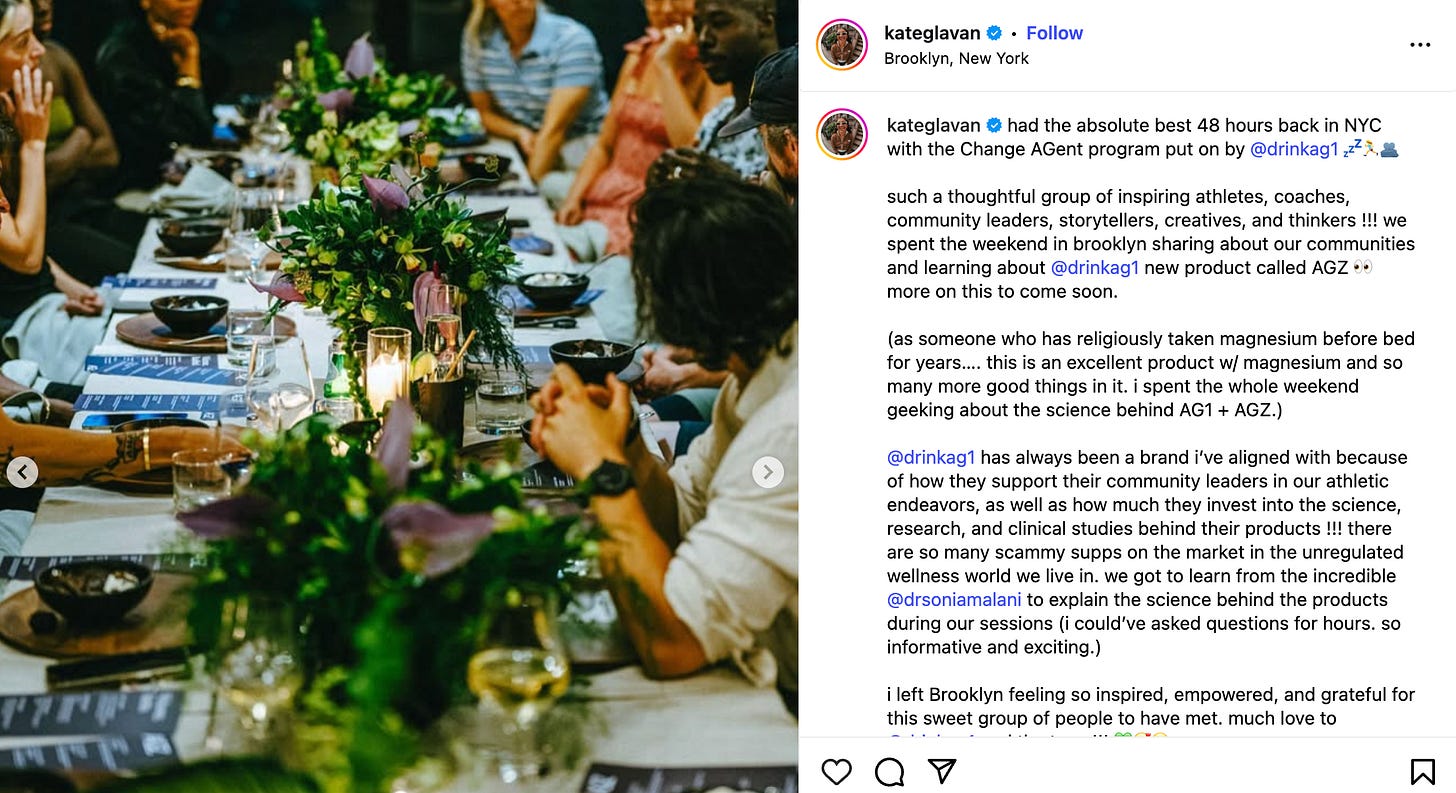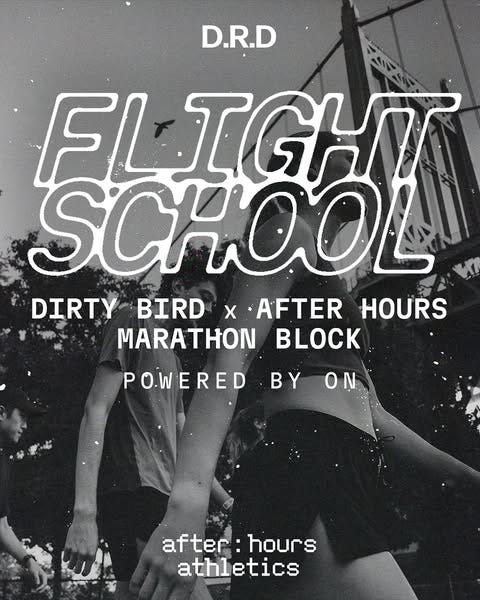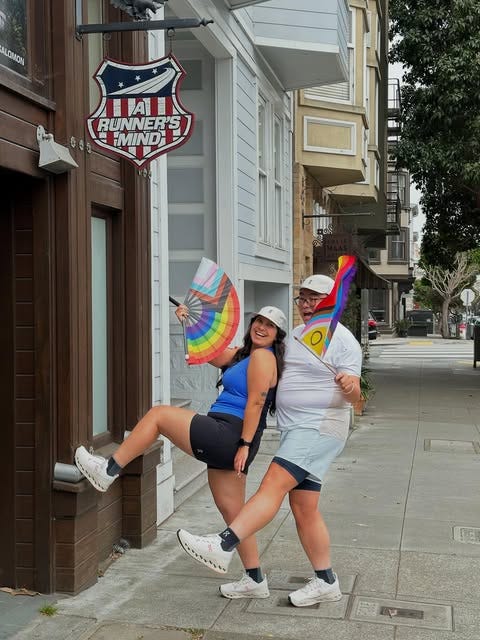Community Trends in Running: Performative vs. Lasting Impact
Community in running is important. It’s what makes running, running. How can brands leverage community in a meaningful way, while growing their business?
What is Community in Running?
Community is everyone’s favorite buzzword. Brands want to harness it, influencers want to build it, and social media managers want to grow it.
For me, running has always been about community and belonging. When I am surrounded by runners I feel most like myself. I love feeling like I have something to contribute, whether it’s cheering for a friend at the Boston Marathon, or leading a shakeout run with a company I work for.
At its core, the running community is kept alive by shared purpose. We all experience suffering and satisfaction defined by workouts, long runs, race results, short shorts, electrolytes, stomach problems, watch tans, blisters, personal bests, personal worsts, super foam, foam rollers, rolling our ankles, and most importantly, self-actualization. And when we run together, we are a universal collective of individuals supporting one another, encouraging each other to cross the finish line.
When we think about community in the brand marketing space, it gets more complicated. The brand always has self-serving interests, which isn’t good or bad, it’s just the reality of investing budget and resources into something. The challenge for many working in running is defining ROI in these scenarios. Most of the time, it’s intangible. There is no clear ROI from a panel discussion. There’s no revenue from a youth mentorship program. That’s why community activations and events are often the first to go when a marketing department has to make budget cuts.
In my experience, there is a constant tension between building community and generating profit, two things that are usually in opposition to each other. Companies will try to make community profitable and scalable through affiliate programs and partnerships with local run clubs to offer gear and discounts. These tactics are effective, but they can feel transactional. Very rarely is there a long-term investment. Your favorite run club might be sponsored by five different brands in a single year. Many brand ambassadors and professional athletes are left feeling disconnected from the brand when they’re viewed as salespeople expected to share links and codes. It begs the question: are profit and community compatible?
Community is a dynamic and conceptual thing. It’s shared values among a group of people, not a spreadsheet of Instagram handles and affiliate codes.
My answer is yes, but as marketers, we have to be willing to live in the unknown and take risks. Community is a dynamic and conceptual thing. It’s shared values among a group of people, not a spreadsheet of Instagram handles and affiliate codes.
The “loneliness epidemic” and social isolation are very real things right now, especially for younger generations. There’s an appetite for connection beyond online presence, and Gen Z isn’t looking to drink at the bar. That’s why run clubs are “the new nightclubs” according to Women’s Health, and why there’s a rise in “wellness fourth spaces” where purpose, health, and belonging collide. The audience is there. Brands that want to build community just need to create the opportunity, and commit to a long-term strategy.
Performative? Exclusive Events Labeled As Community
I’ve noticed a trend during marathons weekends. A lot of brands will host exclusive dinners or weekend-long trips with gift bags and VIP perks, which are publicly documented on social media, but are invite-only. Oftentimes, it’s the same people being invited (influencers with large social platforms, content creators with sleek Instagram profiles) instead of true community leaders, athletes competing, or industry experts. People will post about how they had empowering conversations and uplifted one another, then we never hear about it again.
I question the purpose of these events. They look fun, but they seem to be more about social clout, not about growing the sport. Are VIP attendees going back to their communities to inspire a beginner runner, or are they taking home new shoes and posting about getting a free trip to NYCM paid for by a brand?
Here’s a case study for consideration.
Last year, newly minted Athletic Greens CMO Paulie Dery (formerly Yeti) stated that he’d be joining the company with the explicit goal of expanding AG1's reach beyond its initial focus on podcasts and influencers, turning AG1 into a lifestyle brand (thank god, because we are tired of hearing about AG1 on Huberman Lab, Joe Rogan, and every other biohacking podcast in existence). He emphasized the importance of building a loyal community of AG1 consumers and leveraging relationships with health educators and athletes as part of this strategy.
Recently, AG1 hosted a weekend in Brooklyn to support the launch of their new AGZ drink mix (a mineral, adaptogen, and herb blend). They invited their “Change Agents” to participate: run coaches, influencers, and athletes involved in their local communities. It looked like a typical brand-sponsored weekend with fancy dinners, comped stays, product placement, and curated photography for social media. It would appear this is the community AG1 is trying to build.
However, this is where community-building and sales tactics get blurred. An event like this is a strategic brand initiative to support a product launch. The “Change Agents” are there to learn about a product, then advertise it on their channels. For AG1 to build a lasting community as Dery intends, we need to see how AG1 is getting involved beyond performative fancy ambassador dinners. I know recently they sponsored the Bandit Grand Prix, and they are working with their Change Agents to sponsor local events. So I’m happy to see they’re putting their money where their mouth is. A year or two from now, I’m curious what AG1’s community in running will look like and if they stick to their mission.
Thus defines the fine balance between advertising your product and building lasting relationships with people who will represent your brand. It also highlights the blurred lines between influencer marketing and community activations. The influencer/creator also has self-serving interests, and many of them care more about personal gain, rather than giving back.
Oversaturated Shakeout Runs, And Run Clubs That Try Too Hard
The shakeout run has turned into somewhat of a monster. When 200 people show up for a run and there are 12 photographers trying to capture content for 10 different brands, that feels insane. It’s become standard practice for brands to slap their logo on an Eventbrite, call it community, then do nothing beyond that. Maybe runners get some free stickers and bagels, but it’s probably not going to be super effective in building community long-term.
There’s nothing inherently wrong with this. Shakeout runs are fun, but they’ve become really diluted over the last few years. I tend to avoid them now, because they’re crowded and I’d rather run in a smaller group with a few good friends. I’m more interested in running brands that take a strategic approach to training and group runs, like Tracksmith (note: we won’t talk about the Overland Collection at this time).
When I lived in Boston, I attended some of Tracksmith’s weekend long runs and had a great time. I hung out with friends at the Trackhouse afterwards, and we’d drink seltzers and eat bananas while sitting our sweaty butts on the lounge chairs. Tracksmith does a really good job with consistency in their event marketing, and their dedication to community activations absolutely sells product, especially when they do limited collections at marathon majors. Also, their Twilight 5000m series are some of the best racing opportunities for amateurs like myself. I look forward to doing these races every year.
With the rapid growth of run clubs across the country comes social media savvy individuals looking to make a profit. Some of these run clubs have become their own media companies focused more on selling merch and making content, versus training and coaching.
Take Rawdawg Run Club out of Austin, TX, for example. Founded by Tin Nguyen, a 24-year-old content creator who has partnerships with WHOOP, Runna, and sells a vague $10 “Hybrid Training Program” on his website, the club has caused some controversy in the city. They attract large groups of people, hundreds at a time, and collaborate with food and beverage companies to host parties, but they’ve received a lot of complaints from local residents for disorderly conduct and lacking permits. The concept is disruptive, rebellious, and makes running feel cool, which I like, but there’s a layer of narcissism that feels more about personal gain, and less about uplifting one another. The run club seems like a proxy for someone’s streetwear brand and desire to line their pockets.
The Companies Balancing Run Community and Brand Marketing Effectively
Bandit Running: The Cool Kids
I think this is a given. Bandit is THE brand in the run space right now that everyone wants to be a part of. What they’ve done and what they’re doing is incredible. They’ve managed to balance exclusivity and inclusivity in a way I haven’t seen before. Bandit continues to push the boundaries of the running community with events like The Bandit Grand Prix, The Unsponsored Project, and The Run Program (their marathon training app and coaching program). I’m sure it’s expensive as hell to create all these things, but they have unmatched brand power that simply cannot be bought. It’s lightning in a bottle when you have that, because you can go anywhere and do anything, and draw a crowd. And your product sells out real fast.
On Running: The Global Leader
Of all the leading running shoe companies doing the most in the community right now, On gets first place. Their “Soft Wins” campaign was a huge success, uniting runners from all backgrounds and encouraging people of all abilities to take their easy days easy, so they can train hard when it counts. Their Right To Run initiative, a “movement to protect everyone’s right to run and move”, serves 75+ organizations across the globe to help underrepresented communities gain access to sporting events and use running to rebuild and uplift the lives of refugees.
On also has a wide network of ambassadors across the country who seem to genuinely enjoy being a part of the brand, and aren’t forcing codes and sponsored content. The way On has inserted themselves into events, run clubs, track meets, and marathon afterparties feels genuine, not opportunistic. I really love what On is doing with Dirty Bird RC in New York, including a free 16-week training program leading up to NYCM.
Freaks Of Nature: Community On The Rise
Freaks Of Nature is pretty new to the scene. It’s Kelly Slater’s sunscreen company, and they’re getting involved in running. I’ve never once cared about a sunscreen brand until I started following their Instagram, because their feed is full of cool activations, features real people doing meaningful things in their communities, and encourages a safer, non-toxic approach to sun care. Their ambassadors, aka Freaks, aren’t influencers, they’re people you probably haven’t heard of before doing interesting, often niche athletic endeavors. From a beach cleanup and brunch in Montauk, to a beer mile in Silverlake, Freaks of Nature is having a lot of fun with event pop-ups and community service. I’m excited to see where they take it.
How Can Brands Form Community In Running?
Commit To Long-Term Investment
Community isn’t created overnight. That’s why running brands doing it right are offering marathon training programs, coaching services, and mentorship opportunities that last at least 3 months to a year. They’re also hosting yearly athlete summits and ambassador retreats to bring people together.
I noted the Ciele example in my podcast with Jonathan Levitt, but they’ve been sponsoring The Speed Project for over a decade now through meaningful engagement within the running community. They’ve hosted art galleries in LA featuring TSP photographers, funded a grant program for runners traveling long distances to the race, and filmed some beautiful documentaries. The brand is synonymous with TSP, and contrary to the AG1 example I noted above, the Ciele x TSP partnership feels like it’s giving back in a non-salesy way.
Focus on People, Not Profit
During my time at COROS, I tried to build community by leveraging our sponsored athletes for in-person events, because I knew how much they wanted to be utilized beyond Instagram deliverables. I often felt like I was in an impossible position, because I was supposed to prove how working with an athlete was profitable, while getting feedback from athletes that they felt their relationship with the brand was transactional.
When companies allocate a budget for activations and community-building without the expectation of profit, really cool things can happen. It takes the pressure off marketers to force product and sales into everything, and allows us to focus on building authentic relationships, so we can get the most out of our partners and the communities we want to be a part of. You want your athletes to win and give you results? Then empower them to be who they are, show you care, and create memorable experiences for them that are inextricably tied to your brand.
Champion Inclusivity That’s Not Performative
My friend Rosie recently posted about her 1-year mark working at On. She leads community activations with run clubs on the west coast and noted this in her caption:
“While I am extremely grateful for this company, my life’s work really boils down to supporting diverse runners to move through the praxis of community running. I want people to leave my activations feeling seen and celebrated. I will always be a community member first, and a brand rep second.”
In her role, she recently included Tommy Zhonghuang in an On brand shoot for A Runner’s Mind, a run specialty store in San Francisco. Tommy has autism and doesn’t fit the profile of a typical runner you’d see on a storefront. My brother has autism, so I really appreciated this. Tommy is one of those runners who’s at every event with a smile on his face and a heart of gold. I met him in San Francisco at a live podcast sponsored by Puma. This is what inclusivity is about: elevating people in your community because you believe in them, not because they fill a diversity quota.
Have Fun
If I could boil down community in two words, it would be that: Have Fun. The brands building community are the ones having the most fun through unsanctioned running events, creative pop-ups, unexpected partnerships that make people smile (see: On and Sesame Street), marathon cheer zones, and post-race afterparties. They’re making running approachable, exciting, and progressive. They host activations where you can meet friends, network, and maybe even find love. At the end of the day, that’s all we really want, right?










Another excellent piece Allison! I always enjoy your insights. My favorite word is "genuine" and it feels like that is the ethos that leads to successful community events and engagements. If it feels genuine, it can't also feel sales-y. Thanks for sharing!
I like what you said about the need for community and how running helps to meet that need